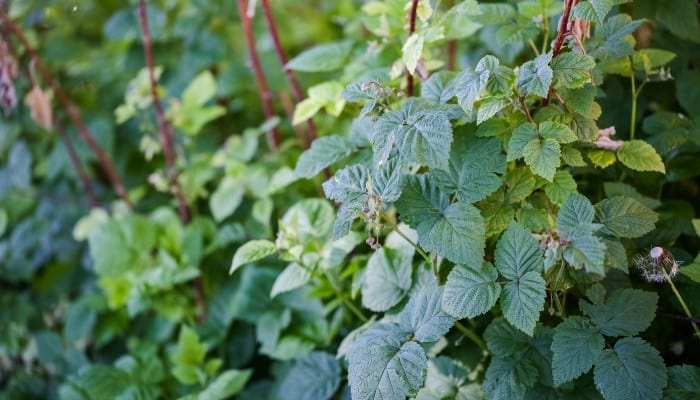It is possible to keep raspberry plants with minimal effort, but they do need specialized care and upkeep in order to stay strong and productive over the long term.
How long do raspberry plants live? Individual raspberry plants live for an average of 10 years with proper care, each year growing new canes that will produce fruit their second year. However, raspberries also send out underground runners that will develop into new plants, so a patch of established plants could survive for many years.
If you are new to cultivating raspberry plants or want to ensure they remain productive for a long time, the information and simple tips below will have you growing and harvesting raspberries like a pro in no time.
How To Keep Raspberry Plants Productive for Years
When tending to plants, there are quite a few basic similarities in terms of care among the numerous types. However, each has specific requirements needed for optimal growth, and raspberries are no exception.
Understanding Raspberry Plant Growth
When introducing raspberry plants into your landscape, it is important to know how they grow and what they require for optimal productivity.
This information will make it easier to take care of your plants and enjoy fruit for many years.
Summer-bearing varieties produce fruit on canes that grew the previous summer. Once they’ve fruited, they can be pruned.
The cane’s first year of growth is spent on growing tall and producing foliage. The next summer, new leaves will appear as will numerous growing berries.
Be very cautious when pruning to not cut any first or second year canes as this will mean no fruit.
Ever-bearing varieties produce fruit on first-year growth, and often these first-year canes will produce again the following season.
Once fruiting is complete, the canes will die and can be pruned without harming the plant.
How To Plant Raspberries
Raspberry plants should go into the ground in the spring as soon as you can turn the soil. Some milder climates can allow you to plant in late fall or early winter on a mild day.
It is best to start with one-year-old plants that you obtain from a greenhouse or local nursery. For the best production of fruit, choose a spot with total sun exposure.
The more sunlight these plants receive, the more fruit you will get although they can still produce quite well in partly shaded areas, depending on your location.
Try to soak the roots in a bucket of water for approximately two hours before transplanting. This way, the root system will not dry out when you plant them in a new location.
These plants will need soil that drains well and has protection from extreme winds.
Raspberry plants have a deep root system, so they will require at least 2 feet in depth if they go into pots rather than the yard.
They require a soil pH level of 5.6 to 6.5 for optimal growth. You can test your soil before choosing a spot.
(I recommend this 3-in-1 meter as it not only reads soil pH but also monitors soil moisture and light – 3 keys to healthy growth!)
Often, adding mulch each year can help maintain the pH level that your plants require for vitality year after year.
The hole where your raspberry plants go should have ample space for the root system to spread out and grow.
Plants should be approximately 18 to 24 inches apart, depending on the variety. Rows should measure between 3 and 4 feet apart for ample future growth.
Center the plant in the hole and fill in around the roots, carefully packing in nutrient-rich soil.
You want to ensure that the raspberry plant is secure with the crown between 1 and 2 inches above the ground, and then water it thoroughly.
Do Raspberry Plants Get Old?
Raspberry plants do grow in stages. The crown and canes from the first two years will grow, mature, and die.
While the root system of a raspberry plant can live 10 years or more, the canes are only biennial and will only survive for two years.
However, new canes are produced every year so that each growing season will have fruiting canes.
How Often Should Raspberry Plants Be Replaced?
Ideally, you will want to replace raspberry plants when they stop producing fruit and are no longer viable.
However, this timeline can be eight to 10 years or more, depending on the soil pH, water drainage, pests, and other environmental factors.
You should not have to worry about replacing your raspberry plants until they are around 10 to 15 years old.
The good news is that raspberries are known for sending out underground runners that will quickly grow into new plants, so you should never have to purchase raspberry plants again once plants are established.
When To Cut Back Raspberry Canes

Cutting back raspberry canes is an essential step to ensure they continuously produce fruit. You want to leave this task until the plant has finished bearing fruit for the season.
The timeline may vary depending on if you have summer-bearing raspberry plants or autumn-bearing ones.
Work through the plant and find the canes that you know have fruited and are brown, dry, and look dead.
Cutting these back will help the raspberry plant provide nutrients to the other plant parts to encourage growth.
To be sure you’ve chosen a dead cane, use your thumb nail to scrape away a small section of bark. If there is green wood underneath, do not cut!
Be sure to cut the cane stalks at the base without damaging the green stalks as these will continue to produce fruit next year.
One helpful trick is to tie a colored string on canes that are actively producing fruit. This way, come pruning time, you’ll know for sure which canes are spent and ready to be pruned.
What Happens If You Don’t Prune Raspberries?
If you do not prune your raspberry plants, they will not thrive and produce fruit as optimally as possible.
In addition, dead canes can create overcrowding and cause the plant to waste essential nutrients on dead areas rather than new growth.
Overcrowded, unpruned canes make live canes compete for sunlight and nutrients, causing your raspberries not to produce the volume of fruit they can when they receive the proper care and maintenance.
Can You Revive a Dead Raspberry Bush?
If your young raspberry bush looks dead, it may need more or less watering, supplemental nutrients or a pH adjustment to help it come back and thrive.
You can revive some young raspberry plants with careful attention to their needs.
If your plant is 10 years old or more, it has likely reached its complete lifespan and will no longer grow and produce fruit, even with the proper care and maintenance.
Related Questions:
How Far Do Raspberry Plants Spread?
You can expect a healthy raspberry plant to spread anywhere from 4-5 feet wide as they send out additional shoots for growth.
Additionally, raspberry plants send out numerous underground runners up to 5 feet away (or more) from the original plants. Without careful monitoring, a raspberry patch can quickly become invasive.
Can You Dig Up and Move Raspberry Plants?
Yes, you can carefully dig up existing raspberry plants and relocate them to a different area of your yard. Just be sure to plant them at the same depth they were growing.
Moving them can also help give them optimal sunlight and nutrients they were not receiving in the original spot.
Conclusion
Raspberry plants are relatively low-maintenance vegetation and can be a terrific addition to any landscape.
Depending on their regular care and maintenance, they can often live anywhere from eight to 10 years.
With proper pruning, soil conditions, and sunlight, you can expect flavorful raspberries for up to 15 years from an original planting, and your carefully tended berry patch will continue to reward you with volunteer plants year after year.

